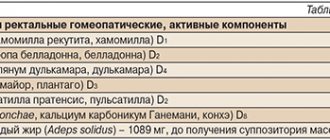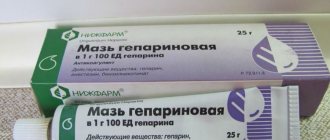Tsefekon D
Cefekon D is an antipyretic and analgesic agent in the form of suppositories for use in pediatrics. The administration of drugs into the rectum (rectal administration) has a number of advantages over the more common oral administration, and in some situations it is the only acceptable one (for vomiting, difficulty swallowing, the need for local therapeutic effects on the rectum and/or colon). In pediatrics, suppositories seem to be an indispensable dosage form, especially for the youngest children who have not yet learned to swallow a tablet or suspension on demand and are not old enough to receive injections. Aspects of rectal administration have been extensively studied by pharmacologists. Penetration of active substances into the circulatory system through the rectal mucosa through passive movement of the substance from an area of higher concentration to an area of lower concentration. The rectum is penetrated by an extensive network of capillaries and larger vessels, and therefore pharmacological substances are well absorbed from its surface. It is important that substances absorbed in the lower rectum do not pass through the liver and are not subject to metabolic transformations. Rectal administration of drugs protects the gastrointestinal mucosa from local irritation. The Russian pharmaceutical industry produces a number of medicines in the form of rectal suppositories, among which Cefekon D occupies a prominent place. The active ingredient of the drug, paracetamol, is very widely used in pediatrics.
The peak concentration of paracetamol in the blood is observed 1 hour after rectal administration (when taking the tablet form this happens faster - after 30-45 minutes). In infants, the bioavailability of the drug is higher than in older children. The severity of the antipyretic effect of paracetamol when administered into the rectum is the same as when administered “per os”. Cefekon D is effective for influenza, acute respiratory infections, pain syndromes of various origins (including headaches, inflammation of peripheral nerves, toothache, injuries, etc.). The drug can be used in children starting from 6 months of age. At an earlier age (1-3 months), a one-time dose of Cefekon D is possible to reduce the temperature after preventive vaccinations. Contraindication to the use of the drug is individual intolerance to paracetamol. The optimal time of administration is after bowel movement. If prompt administration of the drug is necessary, you can do a cleansing enema instead of waiting for a bowel movement. The dose is calculated depending on the patient's body weight according to the table given in the package insert. Duration of the drug course: no more than three days when using the drug as an antipyretic and no more than five days when using the drug as a non-narcotic analgesic. Exceeding the established duration of pharmacotherapy is possible only in agreement with the doctor.
Cefekon D rectal suppositories for children 250 mg 10 pcs
Read the instructions carefully before you start using the drug. Save the instructions, you may need them again. If you have any questions, consult your doctor. The medicine you are using is intended for you personally and should not be given to others as it may cause harm to them even if they have the same symptoms as you. If fever persists for more than 3 days and pain persists for more than 5 days, you should consult your doctor.
Paracetamol can cause serious skin reactions such as acute generalized exanthematous pustulosis, Stevens-Johnson syndrome, toxic epidermal necrolysis, which can be fatal. If skin rash or other signs of hypersensitivity reactions occur, stop taking the drug immediately and consult a doctor.
The simultaneous use of paracetamol with other paracetamol-containing drugs should be avoided, as this may cause an overdose of paracetamol.
There is a risk of overdose in patients suffering from liver disease, chronic alcoholism, chronic malnutrition (due to low levels of glutathione reserves in hepatocytes) and in patients receiving inducers of microsomal liver enzymes. The daily dose of paracetamol should not exceed 4 g in adult patients. For chronic liver diseases, including compensated ones, the daily dose of paracetamol should not exceed 3 g/day.
When using the drug for more than 5-7 days, peripheral blood counts and the functional state of the liver should be monitored. Paracetamol distorts laboratory results in the quantitative determination of glucose and uric acid in plasma.
Long-term use of analgesic drugs in high doses in violation of the instructions for use (especially when using several analgesics simultaneously) can lead to the development of headaches that cannot be treated with increased doses of these drugs.
Long-term use of analgesic drugs (especially combined use of several analgesics) can lead to irreversible kidney damage with the risk of developing kidney failure (analgesic nephropathy).
Abrupt withdrawal of analgesic drugs after their long-term use in high doses can lead to the development of headache, as well as fatigue, muscle pain, nervousness and autonomic symptoms. Withdrawal symptoms decrease within a few days. During this period, you should avoid the use of analgesic drugs and do not start using them without consulting a doctor.
Impact on the ability to drive vehicles and machinery: There is no information on the impact on the ability to drive vehicles and operate machinery.
CEFEKON N (suppositories)
oh contour packaging.
Mode of application.
You need to administer 1 suppository, 1/3 times. It all depends on the disease. Apply for 3-5 days. Five days as an anesthetic, and three days as an antipyretic. It is better to consult a doctor.
I used suppositories for up to 5 days, first 1 suppository, then half a suppository. Because this drug has one side effect: burning and itching, which appeared on the 2nd day of use, so I reduced the dosage. But I decided not to buy these candles for myself anymore. Then, later, I used the lagging suppositories in a smaller dosage. (half a battle).
How did you find out about this drug?
The doctor recommended that if the pain in the lower back is not severe, you can use any painkillers that suit you best. But apparently this is not my option, they didn’t quite fit. I bought these suppositories because of the low price. At that time, finance sang romances)). At that time the drug cost up to 100 rubles. Budget price.
Efficiency.
They helped me reduce my lower back pain. But this drug was not used for severe pain symptoms. If the pain is aching and constant for several days.
****** If the pain is severe, it is difficult to turn around and the pain radiates to the legs. When everything is really bad, I don’t numb the pain, but rather treat diseases. I go to the doctor and take treatment as prescribed by the doctor. Then just painkillers alone will not do, you need complex treatment. Here, as they say, all remedies (medicines) are good. Then I use a lot of drugs to improve my health. My little first aid kit in the fight for a healthy lower back. The drugs were taken at different times. In each individual case (back pain started) I use various medications. These are tablets (or capsules) from the Nurofen series, Voltaren ointments and others, vitamins, patches, so as not to constantly stuff your body with tablets; as an option, I once used the Cefekon N suppository, as well as the drug Amelotex (injection), which is effective for me. * A few words about the drug Cefekon D, which I still buy for children.
Yes, the drug is effective, not only as an analgesic, but also as an antipyretic. I also bought Cefekon D for children. It copes well with fever and helps out if you can’t give your child syrups. The Nurofen suppository can also be considered as an antipyretic. But the difference between the suppository Cefekon D and Nurofen is the price. I note that the child did not complain of discomfort, no side effects were found when using Cefekon D. These suppositories are still available, just in case. Effective drug, low price.
Cefekon N is a drug produced by a domestic manufacturer. Therefore, it is cheaper than similar drugs.
This drug, Cefekon N, has contraindications and side effects. The instructions contain quite a few contraindications.
Instructions.
Back side.
Pros.
1. An effective drug.
2. Budget price, up to 100 rubles.
3. Has less impact on the stomach if you use suppositories rather than tablets.
4. Contour cells open easily. Sometimes the suppository is sealed so tightly that it cannot be printed.))
Minuses.
Significant disadvantages for me:
1. Side effects appear over time.
2. Contraindications.
Not important for me:
1. Must be stored in the refrigerator.
2. Perhaps for some it will be a disadvantage that the method of application is rectal.
The drug helped, but I will no longer buy it for myself or for my children. yes. (Cefekon D).
I rate it as “satisfactory”, but the pain went away after use. Perhaps this drug simply did not suit me, and so the side effects appeared. But I will not recommend Cefekon N.
***And then see for yourself, everyone decides for themselves. Maybe for some this drug will be quite effective and without side effects.***
I don't recommend it.
Cefekon D rectal suppositories for children 100 mg 10 pcs
Read the instructions carefully before you start using the drug. Save the instructions, you may need them again. If you have any questions, consult your doctor. The medicine you are using is intended for you personally and should not be given to others as it may cause harm to them even if they have the same symptoms as you. If fever persists for more than 3 days and pain persists for more than 5 days, you should consult your doctor.
Paracetamol can cause serious skin reactions such as acute generalized exanthematous pustulosis, Stevens-Johnson syndrome, toxic epidermal necrolysis, which can be fatal. If skin rash or other signs of hypersensitivity reactions occur, stop taking the drug immediately and consult a doctor.
The simultaneous use of paracetamol with other paracetamol-containing drugs should be avoided, as this may cause an overdose of paracetamol.
There is a risk of overdose in patients suffering from liver disease, chronic alcoholism, chronic malnutrition (due to low levels of glutathione reserves in hepatocytes) and in patients receiving inducers of microsomal liver enzymes. The daily dose of paracetamol should not exceed 4 g in adult patients. For chronic liver diseases, including compensated ones, the daily dose of paracetamol should not exceed 3 g/day.
When using the drug for more than 5-7 days, peripheral blood counts and the functional state of the liver should be monitored. Paracetamol distorts laboratory results in the quantitative determination of glucose and uric acid in plasma.
Long-term use of analgesic drugs in high doses in violation of the instructions for use (especially when using several analgesics simultaneously) can lead to the development of headaches that cannot be treated with increased doses of these drugs.
Long-term use of analgesic drugs (especially combined use of several analgesics) can lead to irreversible kidney damage with the risk of developing kidney failure (analgesic nephropathy).
Abrupt withdrawal of analgesic drugs after their long-term use in high doses can lead to the development of headache, as well as fatigue, muscle pain, nervousness and autonomic symptoms. Withdrawal symptoms decrease within a few days. During this period, you should avoid the use of analgesic drugs and do not start using them without consulting a doctor.
Impact on the ability to drive vehicles and machinery: There is no information on the impact on the ability to drive vehicles and operate machinery.





